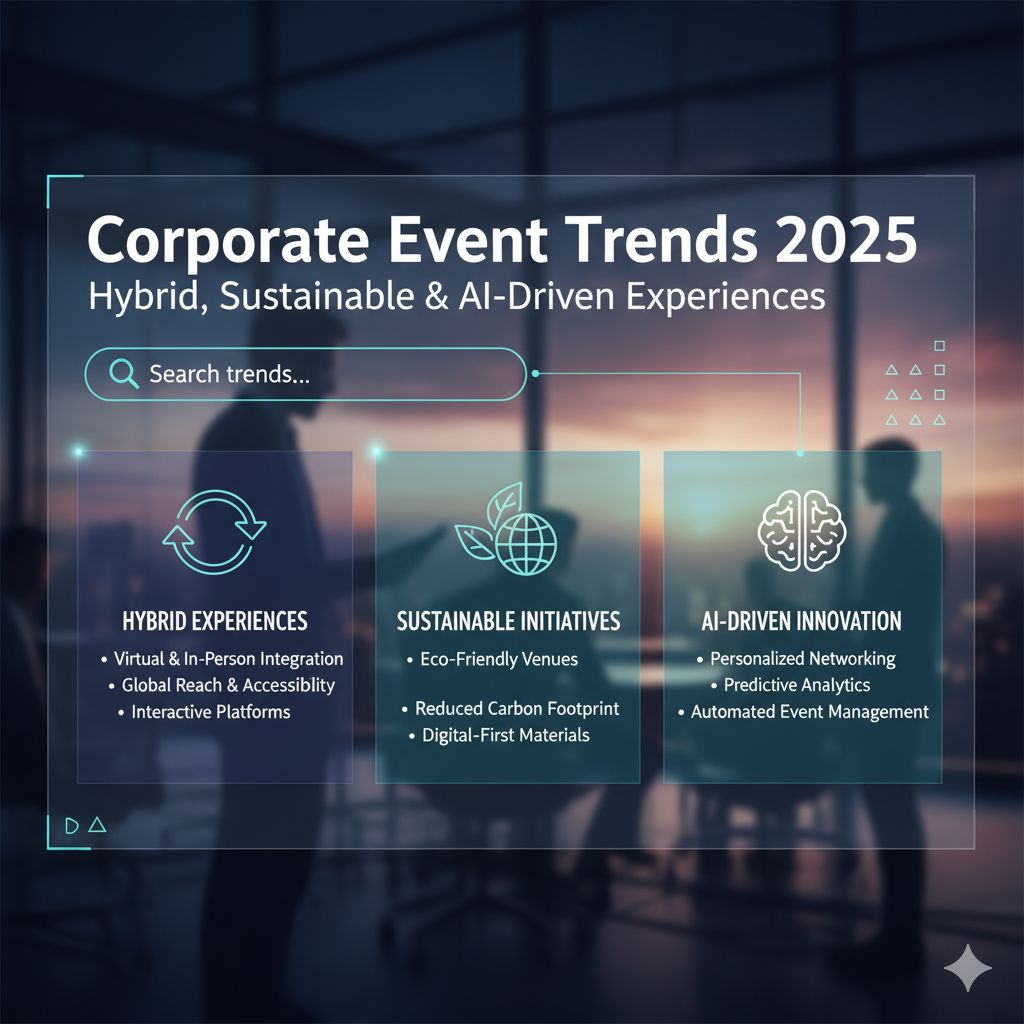Introduction — corporate events that actually work for busy teams
Corporate life moves fast. Between deadlines, client calls and quarterly targets, organising corporate events can easily slip down the priority list — until the day you actually need one to run smoothly. Whether it's a client offsite, a town hall, an internal workshop, or a Friday afternoon office event, good planning turns a stressful task into a strategic win.
This guide is written for corporate workers (20–60) who want practical, time-saving advice on corporate meetings, corporate bookings, corporate event management, and creating memorable office events—without becoming a full-time planner. Along the way you'll find checklists, vendor tips, and ways to use tools like the Shubhvite event management platform to reduce admin and increase impact.
Why corporate events matter (and when to invest)
A well-run corporate event does three things: it informs, it connects, and it motivates. You don't need a huge budget to hit those goals — just clear objectives.
When to prioritise an event:
- Sales kickoff or product launches (business-critical).
- Quarterly all-hands / town halls (company alignment).
- Team offsites or retreats (culture & corporate bonding).
- Client-facing events (relationships & pipelines).
- Recognition and reward office events (retention & morale).
If your event has measurable business outcomes (pipeline, NPS, retention), treat it like a project — assign owners and use a simple corporate event management workflow.
Types of corporate events — pick the right format
Different events require different approaches. Here's a quick breakdown:
- Corporate meetings — Focused, agenda-driven gatherings (board meetings, department syncs).
- Conferences & seminars — Public-facing or multi-team events with content and speakers.
- Workshops & training — Hands-on learning with breakout sessions.
- Client events — Demos, product launches, or VIP dinners.
- Office events — Smaller internal celebrations like birthdays, anniversaries, or culture days.
- Hybrid events — Combine in-person and virtual participation to widen reach.
Choosing the right format up front simplifies logistics, budgets and follow-up.
Quick-start planning timeline (for busy organisers)
Use this compact timeline for standard mid-size corporate events (100–300 attendees):
- 12 weeks out: Define objectives & KPIs (attendance, leads, NPS). Draft a one-page event brief. Assign an internal owner.
- 8 weeks out: Shortlist venues; request quotes for corporate bookings. Book key vendors (AV, catering, security).
- 6 weeks out: Launch registration (use an event management tool). Confirm speakers and partners.
- 2–3 weeks out: Finalise run-of-show. Confirm logistics and dietary needs. Run AV rehearsals and test hybrid setup.
- Event day: Set up a command centre. Monitor timelines and feedback.
- 1–2 weeks after: Share post-event report. Measure KPIs and learnings.
For smaller corporate meetings or office events, compress the timeline — but keep the same checklist logic.
Corporate bookings: how to choose the right venue (fast)
When you're short on time, venue choice makes or breaks the event. Consider these checklist items for efficient corporate bookings:
- Location & accessibility: Close to public transport and hotels if clients are attending.
- Capacity & layout options: Theatre, classroom, cabaret — pick one that fits your agenda.
- AV & connectivity: Confirm bandwidth and test hybrid streaming options.
- Catering flexibility: Menu options for dietary restrictions.
- Pricing transparency: Ask about hidden costs like service charges, overtime, or cleaning fees.
- Cancellation & contingency policy: Understand penalties and rescheduling options.
Corporate event management essentials — a practical checklist
Whether you manage events internally or work with agencies, these fundamentals will keep things under control:
- One-page event brief: Objective, target audience, KPI, budget, and owners.
- Vendor SOWs: Signed statements of work covering deliverables and payment milestones.
- Run-of-show: Time-coded script with speaker names, cue times, and contact numbers.
- Registration & badge system: Pre-printed badges or just QR-code check-ins for speed.
- On-site command centre: Contact list, floor plan, and contingency plan.
- Post-event report: Attendance vs RSVP, feedback scores, lead quality, and budget variance.
Use an event management platform to centralise attendee lists, SOWs, and run-of-show documents so nothing lives only in emails.
Making corporate meetings meaningful (without wasting time)
A corporate meeting with a clear agenda is the best use of people's time. Keep these meeting rules:
- Share a pre-read (2 pages max) 48 hours in advance.
- Start and end on time — publish time-boxed agenda slots.
- Use a facilitator for larger cross-functional meetings.
- Assign action owners and publish minutes within 24 hours.
For recurring meetings that follow a similar flow, use templates in your corporate event management tool so organisers don't reinvent the wheel each time.
Office events: low-effort, high-impact ideas
Office events are the cultural glue. Here are simple formats that don't derail work:
- Lunchtime learning: 30–45 minute talk with food.
- Micro celebrations: 15-minute recognition moments for achievements.
- Theme Fridays: Casual dress + short activity.
- Wellness breaks: Guided stretch or meditation session.
These events are perfect for quick wins in employee engagement and cost very little when planned with internal owners.
The role of the corporate event planner (internal vs external)
You can use an internal corporate event planner or hire an agency — the right choice depends on frequency and complexity:
- Internal planner — Best if you run many events and need institutional knowledge. They're cost-effective for recurring corporate activities.
- External agency — Ideal for one-off large events or when you need specialist staging, lighting or sponsorship management.
Whichever you choose, make sure responsibilities are clear: who owns vendor communication, who owns invites, and who owns the KPI report.
Technology & platforms — making your life easier
A modern event management platform should let you:
- Create registration pages and handle corporate bookings.
- Send branded invites and automated reminders.
- Manage check-ins with QR codes.
- Route leads to CRM for client events.
- Capture real-time analytics and attendee engagement.
For hybrid events, ensure the platform integrates with your streaming provider and supports multi-location logins. Tools like the Shubhvite app centralise these functions so organisers can focus on content, not chaos.
Budgeting and vendor negotiation (practical tips)
Budgets matter. Keep these vendor negotiation tactics in your pocket:
- Benchmark: Always get at least 3 quotes for venue, catering, and AV.
- Bundle services: Venues often offer lower rates when they manage catering and AV.
- Payment milestones: Split payments (30/40/30) to balance vendor cash flow and your protection.
- Add-ons in writing: If you ask for extras, get them in an updated SOW.
- Contingency fund: Reserve 8–10% for unexpected costs, especially for large corporate events.
When you request proposals, include a simple scoring matrix (price, capability, past experience, flexibility) to choose objectively.
Content & programming — make every minute count
Programming determines attendee experience. For corporate audiences:
- Mix short keynotes (20–30 minutes) with panels or breakout workshops.
- Add a 10–15 minute interactive segment (live poll or Q&A).
- For client events, include product demos with hands-on zones.
- For internal events, include recognition moments and clear takeaways.
For corporate meetings, the content should produce decisions or actions; for conferences, design experiences that produce leads or learning outcomes.
Measuring success — KPIs that matter
What you measure drives behaviour. Use these KPIs:
- Attendance vs RSVP (logistics success).
- Net promoter score (NPS) or satisfaction rating (experience quality).
- Lead quality / demos booked (for client events).
- Employee engagement lift (for internal events; pre/post surveys).
- Budget variance (financial discipline).
Create a one-page post-event report summarising these metrics and three key learnings to improve the next event.
Sustainable and inclusive events (simple wins)
Sustainability and inclusiveness are now baseline expectations:
- Use digital invites and QR check-ins to reduce print.
- Source local catering and request reusable serviceware.
- Provide clear accessibility info in invites and at venues.
- Offer remote attendance options for hybrid inclusivity.
Small choices improve brand perception and reduce waste — and they're easy to implement with a little planning.
Conclusion — run better corporate events with less stress
Great corporate events aren't about big budgets; they're about clarity, ownership, and the right tools. If you standardise processes — from corporate bookings and run-of-show templates to using an event management platform — you get consistent results with less firefighting.
Ready to simplify your next event? Explore Shubhvite's features for planning, registration, and hybrid delivery at Shubhvite App, or download free templates at Resources. If you'd like help planning a large event, our corporate team can assist: Corporate Event Services — or just drop us a line at Contact.
Frequently Asked Questions
For mid-size events (100–300 attendees), start planning 12 weeks out. For smaller corporate meetings or office events, 1–3 weeks is usually enough. The key is to define objectives early, assign owners, and use a structured timeline.
A single internal owner — even if an agency executes — to reduce cross-functional friction. This person should handle vendor communication, coordinate with the venue, and ensure all requirements are met on time.
Initially yes (AV + production costs), but hybrid events increase reach and often lower cost-per-lead by including virtual attendees. They also reduce venue and travel costs while expanding your audience.
Define outcome metrics like decisions made, actions assigned, or satisfaction scores. Use KPIs such as attendance vs RSVP, NPS, and pre/post feedback. Create a post-event report summarizing these metrics and key learnings.


